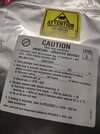I've had nothing but bad things to say about using these for crystal replacements, but at $2.77 a piece, I couldn't help but add a couple to the last mouser cart.

What puzzles me is the excessive packaging and humidity warnings. The package sounds like it has desiccator beads rolling around in it and I an now afraid to open it because I am not ready to use them. If mouser is that worried about moisture, what am I supposed to do after it is on the board? Bury it in wax? Those cheap modules on amazon don't do that. How can moisture be an issue in storage and not in the application?
My next bit of confusion was that the highest stability crystals Mouser had were 10ppm. I assume that is a slow drift and not all over the place, but if thats the best crystal I can buy (at the same price as a complete module on amazon), what crystals did they use on those cheap modules? 50ppm? 100? Looks like I will I need to add a micro just to keep updating this thing as it drifts. If I need to build a board with a programming interface and a bandpass filter, I am not sure it would fit in a radio.. I would have ordered the ones with a built in VCO, but I am not too good with soldering things with pads underneath the part, so I didn't. I think this is an AM only project.

What puzzles me is the excessive packaging and humidity warnings. The package sounds like it has desiccator beads rolling around in it and I an now afraid to open it because I am not ready to use them. If mouser is that worried about moisture, what am I supposed to do after it is on the board? Bury it in wax? Those cheap modules on amazon don't do that. How can moisture be an issue in storage and not in the application?
My next bit of confusion was that the highest stability crystals Mouser had were 10ppm. I assume that is a slow drift and not all over the place, but if thats the best crystal I can buy (at the same price as a complete module on amazon), what crystals did they use on those cheap modules? 50ppm? 100? Looks like I will I need to add a micro just to keep updating this thing as it drifts. If I need to build a board with a programming interface and a bandpass filter, I am not sure it would fit in a radio.. I would have ordered the ones with a built in VCO, but I am not too good with soldering things with pads underneath the part, so I didn't. I think this is an AM only project.
